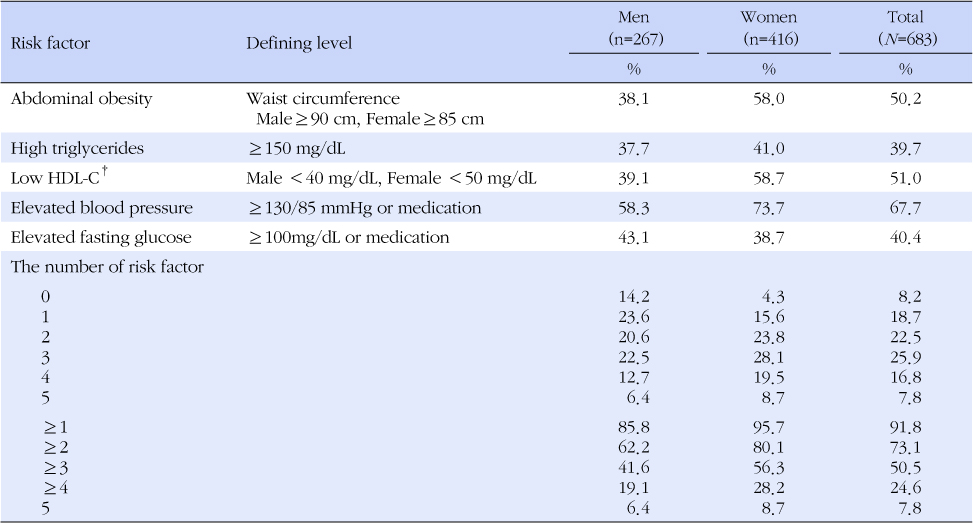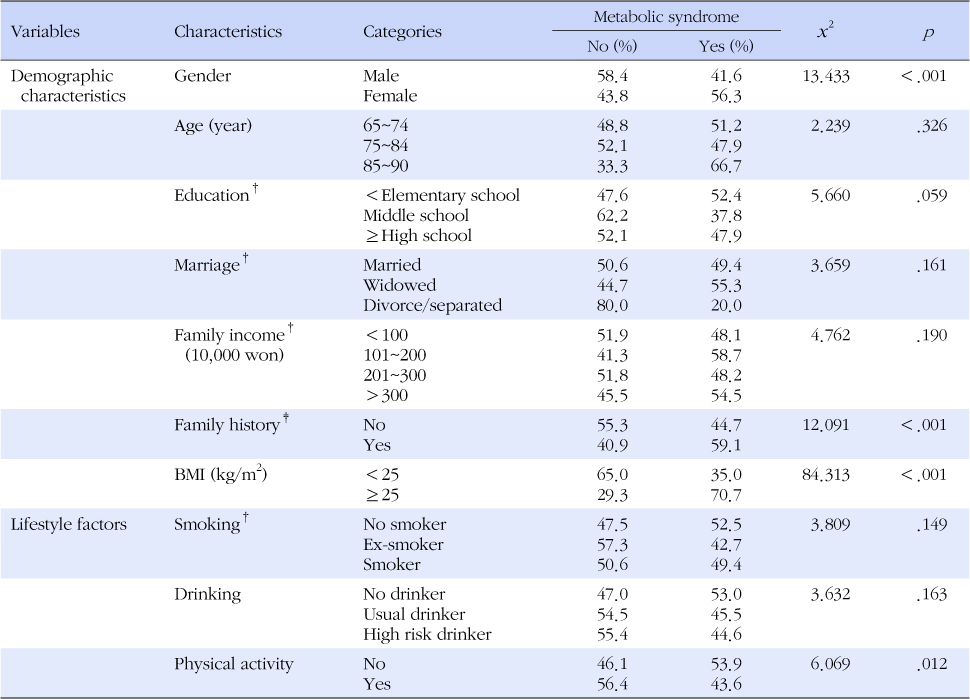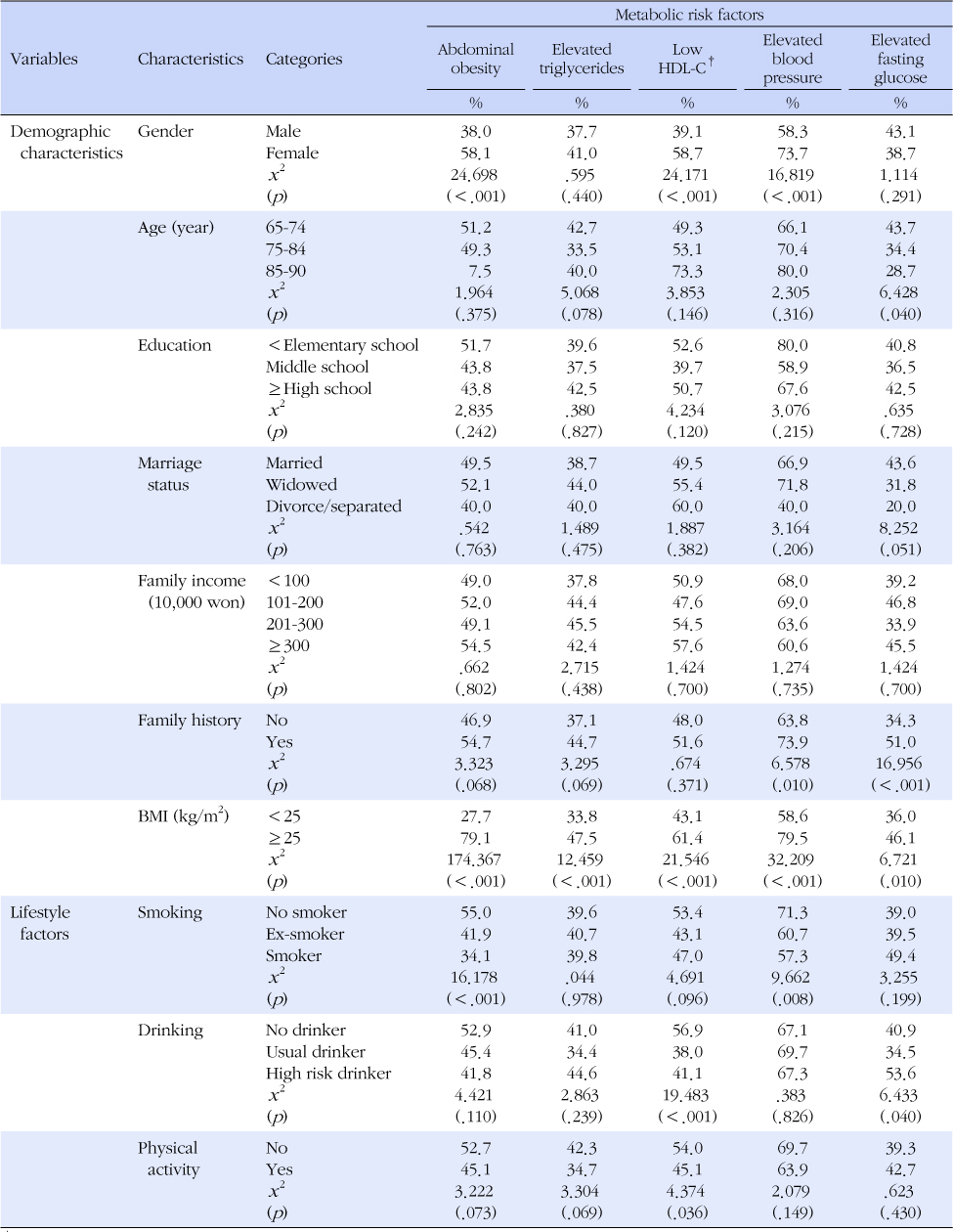Articles
- Page Path
- HOME > J Korean Acad Community Health Nurs > Volume 24(2); 2013 > Article
-
Original Article
- Prevalence of the Metabolic Syndrome and Its associated Factors among Elders in a Rural Community
- Bongjeong Kim
-
Journal of Korean Academy of Community Health Nursing 2013;24(2):225-235.
DOI: https://doi.org/10.12799/jkachn.2013.24.2.225
Published online: June 30, 2013
Department of Nursing, Yeoju Institute of Technology, Yeoju, Korea.
• Received: March 1, 2013 • Accepted: June 23, 2013
© 2013 Korean Academy of Community Health Nursing
- 573 Views
- 1 Download
- 2 Crossref
Abstract
-
Purpose
- The purpose of this study is to identify the prevalence of the metabolic syndrome (MS) and factors associated with it among elders in a rural community.
-
Methods
- Data were collected from 683 subjects with a questionnaire, physical measurement, and blood test. The prevalence of the MS was determined by AHA/NHLBI and waist circumference cutoff points for Koreans.
-
Results
- The prevalence of the MS was 50.5% in total (41.6% in men, 56.3% in women) while the prevalence of 5 metabolic risk factors was 67.7% for elevated blood pressure, 51.0% for low HDL-cholesterol, and 50.2% for abdominal obesity. Risk factors associated with the prevalence of the MS included family history, BMI, and physical activity; significant factors associated with that of metabolic components included family history, BMI, smoking, drinking, and physical activity. Especially, a higher BMI was a strong risk factor of the prevalence of abdominal obesity as well as the MS and its components.
-
Conclusion
- The findings indicate that nurses should care for elders based on each metabolic component regarding its prevalence level and concentrate primarily on reducing elevated blood pressure, low HDL-cholesterol by controlling the main risk factor, abdominal obesity through lifestyle modification.
Table 1Prevalence of Each Risk Factor of Metabolic Syndrome and Clustering of Risk Factors of Metabolic Syndrome


Table 2Difference of the Prevalence of Metabolic Syndrome by Demographic and Lifestyle Factors (N=683)


- 1. Butler J, Rodondi N, Zhu Y, Figaro K, Fazio S, Vaughan DE, et al. Metabolic syndrome and the risk of cardiovascular disease in older adults. J Am Coll Cardiol 2006;47(8):1595–1602.
- 2. Denys K, Cankurtaran M, Janssens W, Petrovic M. Metabolic syndrome in the elderly: An overview of the evidence. Acta Clin Belg 2009;64(1):23–34.
- 3. Devarj S, Wang-Polagruto J, Polagruto J, Keen CL, Jialal I. High-fat, energy-dense, fast-food-style breakfast results in an increase in oxidative stress in metabolic syndrome. Metabolism 2008;57(6):867–870.
- 4. Dominguez LJ, Barbagallo M. The cardiometabolic syndrome and sarcopenic obesity in older persons. J Cardiometab Syndr 2007;2(3):183–189.
- 5. Faul F, Erdfelder E, Buchner A, Lang AG. Statistical power analyses using G*Power 3.1: Tests for correlation and regression analyses. Behav Res Methods 2009;41(4):1149–1160.
- 6. Ford ES, Giles WH, Dietz WH. Prevalence of metabolic syndrome among US Adults. JAMA 2002;287(3):356–359.
- 7. Galassi A, He J. Metabolic syndrome and risk of cardiovascular disease: A meta-analysis. Am J Med 2006;119(10):812–819.
- 8. Gause-Nilsson I, Gherman S, Kumar Dey D, Kennerfalk A, Steen B. Prevalence of metabolic syndrome in an elderly Swedish population. Acta Diabetol 2006;43(4):120–126.
- 9. Grundy SM, Cleeman JI, Daniels SR, Donato KA, Eckel RH, Franklin BA, et al. Diagnosis and management of the metabolic syndrome: An American Heart Association/ National Heart, Lung, and Blood Institute Scientific Statement. Circulation 2005;112(17):2735–2752.
- 10. Hunt KJ, Heiss G, Sholinsky PD, Province MA. Familial history of metabolic disorders and the multiple metabolic syndrome: The NHLBI family heart study. Genet Epidemiol 2000;19(4):395–409.
- 11. Im MY, Lee YR, Han SJ, Cho CM. The Effects of lifestyle factors on metabolic syndrome among Koran adults. J Korean Acad Community Health Nurs 2012;23(1):13–21.
- 12. Kim JI. Factors affecting metabolic syndrome in a rural community. J Korean Soc Health Educ Promot 2009;26(1):81–92.
- 13. Korean Center for Disease Control and Prevention. Indepth analyses of the third Korea national health and nutrition examination: The health examination part 2007;Seoul: Author.
- 14. Lee EH, Cho S, Kwon EJ, Park JY, Hyun SM, Kim M. Prevalence and related of metabolic syndrome among Korean older adults. J Korean Soc Health Educ Promot 2009;26(4):129–143.
- 15. Lee HS, Kwon CS. Prevalence of metabolic syndrome and related risk factors of elderly residents in Andong rural area: Based on the anthropometric measurements and health behaviors. J Korean Soc Food Sci Nutr 2010;39(10):511–517.
- 16. Lee K. Gender-specific relationships between alcohol drinking patterns and metabolic syndrome: The Korea national health and nutrition examination survey 2008. Public Health Nutr 2012;15(10):1917–1924.
- 17. Lee WY, Jung CH, Park JS, Rhee EJ, Kim SW. Effects of smoking, alcohol, education, and family history on the metabolic syndrome as defined by th ATPIII. Diabetes Res Clin Pract 2005;67(1):70–77.
- 18. Lim J, Kim S, Ke S, Cho B. The Prevalence of obesity, abdominal obesity and metabolic syndrome among elderly in general population. Korean J Fam Med 2011;32(2):128–134.
- 19. Lim S, Jang HC, Lee HK, Kim KC, Park C, Cho NH. A rural-urban comparison of the characteristics of the metabolic syndrome by gender in Korea: The Korean Health and Genome Study (KHGS). J Endocrinol Invest 2006;29(4):313–319.
- 20. Lim S, Lee HK, Park S. Changes in the characteristicsof metabolic syndrome in Korea over the period 1998-2001 as determined by Korean national health and nutrition examination surveys. Diabetes Care 2005;28(7):1810–1812.
- 21. Maggi S, Noale M, Gallina P, Bianchi D, Marzari C, Limongi F, et al. Metabolic syndrome, diabetes, and cardiovascular disease in an elderly caucasian cohort: The Italian longitudinal study on aging. J Gerontol A Biol Sci Med Sci 2006;61(5):505–510.
- 22. Mozaffarian D, Kamineni A, Prineas RJ, Siscovick DS. Metabolic syndrome and mortality in older adults: The cardiovascular health study. Arch Intern Med 2008;168(9):969–978.
- 23. National Statistical Office. 2010 report on the causes of death statistics 2011;10 08 Retrieved January 5, 2012. from http://kostat.go.kr/wnsearch/search.jsp
- 24. Oh SW, Yoon YS, Lee ES, Kim WK, Park C, Lee S, et al. Association between cigarette smoking and metabolic syndrome: The Korea national health and nutrition examination survey. Diabetes Care 2005;28(8):2064–2066.
- 25. Park HS, Oh SW, Cho SI, Choi WH, Kim YS. The metabolic syndrome and associated lifestyle factors among South Korean adults. Int J Epidemiol 2004;33(2):328336.
- 26. Scuteri A, Morrell CH, Najjar SS, Lakatta EG. The metabolic syndrome in older individuals: Prevalence and prediction of cardiovascular events. The cardiovascular health study. Diabetes Care 2005;28(4):882–887.
- 27. Shin CY, Yun KE, Park HS. Blood pressure has a greater impact on cardiovascular mortality than other components of metabolic syndrome in Koreans. Atherosclerosis 2009;205(2):614–619.
- 28. Sinclair A, Viljoen A. The metabolic syndrome in older persons. Clin Geriatr Med 2010;26(2):261–274.
- 29. Zamboni M, Mazzali G, Harris TB, Meigs JB, Di Francesco V, Fantin F, et al. Health consequences of obesity in the elderly: A review of four unresolved questions. Int J Obes (Lond) 2005;29(9):1011–1029.
- 30. Warensjö C, Sundstrom J, Lind L, Vessby B. Factor analysis of fatty acids in serum lipids as a measure of dietary fat quality in relation to the metabolic syndrome in men. Am J Clin Nutr 2006;84(2):442–448.
Figure & Data
References
Citations
Citations to this article as recorded by 

- Sociodemographic and Health Characteristics Associated with Metabolic Syndrome in Men and Women Aged ≥50 Years
Goeun Chung, Hye-Sun Jung, Hye-Jin Kim
Metabolic Syndrome and Related Disorders.2021; 19(3): 159. CrossRef - Prevalence and correlates of metabolic syndrome and its components in elderly Korean adults
Seonho Kim, Wi-Young So
Experimental Gerontology.2016; 84: 107. CrossRef

 KACHN
KACHN


 PubReader
PubReader Cite
Cite

